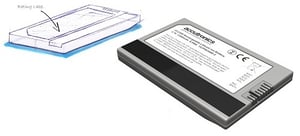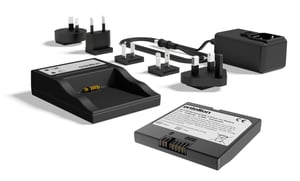Most of the work that takes place inside the battery manufacturing facility of Accutronics Ltd in Staffordshire, UK is highly confidential (bespoke batteries built under strict non-disclosure agreements). In this rare glimpse behind-the-scenes, we discover how the pre-engineered range of Entellion credit card batteries evolved from the drawing board to the production line.
‘Lightbulb moment’ – identifying the need

Designing the product

Many elements were considered, including:
- Chemistry – to get the high volumetric and gravimetric energy density required for our concept, the decision was made to use the latest 3.7V Lithium Ion cells with a Lithium Cobalt Oxide (LiCo2) cathode
- Size – choosing a credit card footprint meant that OEMs have that familiarity with the dimensions without needing to see the product (86.4mm x 54.0mm)
- Capacity – with capacity being one of the major battery specifications that OEMs consider, we decided to develop two different batteries - one offering a typical capacity of 2300mAh and the other 3800mAh
- Temperature range – it was vital for the batteries to function well in environments where modern handheld and wearable electronic devices are used; the result was to offer a wide operating temperature range of -10⁰C to +50⁰C
- Safety – ensuring the batteries stay safe under all operating conditions; an active protection system of electronic circuitry was incorporated to protect against over-charge, over-discharge, over-current and short-circuiting
Quality and testing
After ensuring the high-quality design we also wanted to be sure the CC2300 and CC3800 could easily be incorporated into handheld and wearable electronic devices, hence obtaining regulatory certification.
- Transportation – all models are tested to and meet the requirements of UN 38.3
- Safety – as compliance to the IEC 62133 standard is a requirement of many device standards the batteries were certified prior to launch
- CE Compliance – all models meet the requirements of EMC directive 2004/108/EC and are CE marked
“What’s in a name?” – the finishing touch
Now we had our pre-qualified, pre-engineered batteries ready for market, we needed a name that could instantly describe them. As the compactness of the range is its main selling point, it was decided that the descriptive nickname should tell everyone its approximate size and so the “credit card battery” was born.
Expanding the range

Yet as devices continued to get smaller and lighter further development was instigated and as a result the CC1150 mini was born. Even though the latest product in the range measures half the size of its predecessors it’s still packed with the same powerful features and regulatory certifications.
All the batteries we design, manufacture and distribute at Accutronics Ltd are of the highest standard. Everything is considered, from the requirements of OEMs to the design, quality and testing.